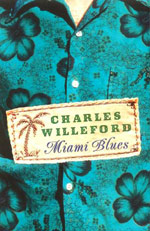The Difference | |

| For several years I kept coming upon the name Charles Willeford on the jackets of other books, and as a result his name was in my notebook as one to check out. It wasn't until earlier this year, however, that I seemed to get around to it, when I picked up No Exit's back to back publication of High Priest Of California and Wild Wives. Both hit me right in the gut with a sucker punch. Written in a sleazy San Francisco hotel back in the early '50s when he was on leave from the army, Wild Wives is a short and snappy pulp thriller stuffed to the gills with brutal amorality. It's the kind of tale loaded with dialogue you want to quote endlessly or lift wholesale and put into stage plays or movies that star Sterling Hayden. High Priest of California is similarly pacey and filled with characters you really wouldn't want to take home to share tea with your Mom. Not unless your Mom has a penchant for slimy smooth talking second hand car salesmen. As an introduction to the world of Charles Willeford, this back to back is a great starting point. You might be tempted with the Charles Willeford Omnibus (No Exit) as an alternative way into Willeford. My advice is to not bother. Opener Pick Up is fair enough, but just a bit too obtuse and lacking in the great pace of the Wild Wives and High Priest stories. In Pick Up you get the impression that Willeford is just trying too hard to be clever, and as a result the ending just doesn't really either surprise or pack any impact. Maybe it had more punch at the time of its publication back in the late '60s, but whatever. It's hardly essential Willeford. Similarly Cockfighter is one that passed my by, barely holding my attention. Third title in the Omnibus is The Burnt Orange Heresy, which some say is a classic Willeford story. Personally I hated it. Willeford was apparently very keen on the Art world, and took a lot of interest in it. There are references to Art in several of his books, but the Burnt Orange Heresy is the one where it takes centre stage. The book is clearly intended as a dig at the contemporary Art world and market but sadly ends up being just the bitter rant of someone out of touch with Modernity, someone who still equates Art with the specifics of painting, and more particularly one suspects, figurative painting. If Willeford were around today, I've no doubt he would be applauding the Stuckists. And like the rants and ravings of the Stuckists, Burnt Orange Heresy just irritated the hell out of me. Avoid at all costs if the likes of Marcel Duchamp even vaguely appeal to you. |

| Better by far to go for the classic tales of descent into bitter madness that people the terrific The Machine In Ward Eleven collection (No Exit). These short stories from the early 1960s are packed full of paranoia and sharp swipes at the American Dream, and as such they are eerily prescient of the kinds of attitudes that started to filter through at the tail end of that decade as Americans in particular appeared to wake up to the hypocrisy of their system. But as the jacket notes point out, Willeford was there first, with these strange Sci-Fi tales of chilling foresight. Or if Sci-Fi isn't your bag, go for the awesome Western short The Difference (Canongate Crime Classics). Originally published back in 1971 as The Hombre from Sonora by 'Will Charles', The Difference is a short sharp shock of a tale that kicks the dust in your eyes with the point of a beaten leather boot and then sticks a Colt forty five barrel hard into your ribs. Willeford himself said of the book that it ought not to be understood too fast, and that's a fair point because although the book has lots of typical Western trappings, its undertone is much darker and the blurring of the sense of 'honour' that prevails in many Westerns with amorality and simple vengeance is pointed. The book is a dramatic deconstruction of the classic American Western, laying waste to myth and replacing it instead with harshness and allegories about global expansionism. The Difference is truly a wonderful book. |

| Last, but certainly not least, are Miami Blues, New Hope For The Dead, Sideswipe and The Way We Die Now (all No Exit). Set in Miami and its Floridian surrounds, these four novels are magnificent portrayals of place, and are peopled with Willeford's best drawn characters, most notably the homicide detective Hoke Moseley who is at the heart of the quartet. Thankfully, he's certainly no Ricardo Tubbs or Sonny Crockett. Written throughout the 1980s when Miami was in the process of becoming the then Crime Capitol of the USA, these Moseley novels are as far from the smooth sleek designer fashion clad sheen of Miami Vice as you could get. Instead there is a gritty determination to find justice and truth, whatever 'truth' might mean in these strange days. The books are by turns satirical, harrowing, amusing, seedy and strangely tender, and are packed with psychotic career criminals, disfigured strippers and junkies. As usual Elmore Leonard is right on the money when he says of the Hoke Moseley series that 'no-one writes a better crime novel than Charles Willeford'. And if it's good enough for Elmore Leonard, it should damn well be good enough for you. © Alistair Fitchett 2002 |